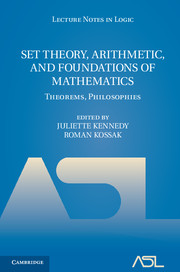Book contents
- Frontmatter
- Contents
- Introduction
- Historical remarks on Suslin's problem
- The continuum hypothesis, the generic-multiverse of sets, and the Ω conjecture
- ω-models of finite set theory
- Tennenbaum's theorem for models of arithmetic
- Hierarchies of subsystems of weak arithmetic
- Diophantine correct open induction
- Tennenbaum's theorem and recursive reducts
- History of constructivism in the 20th century
- A very short history of ultrafinitism
- Sue Toledo's notes of her conversations with Gödel in 1972–5
- Stanley Tennenbaum's Socrates
- Tennenbaum's proof of the irrationality of √2
- References
Tennenbaum's theorem and recursive reducts
Published online by Cambridge University Press: 07 October 2011
- Frontmatter
- Contents
- Introduction
- Historical remarks on Suslin's problem
- The continuum hypothesis, the generic-multiverse of sets, and the Ω conjecture
- ω-models of finite set theory
- Tennenbaum's theorem for models of arithmetic
- Hierarchies of subsystems of weak arithmetic
- Diophantine correct open induction
- Tennenbaum's theorem and recursive reducts
- History of constructivism in the 20th century
- A very short history of ultrafinitism
- Sue Toledo's notes of her conversations with Gödel in 1972–5
- Stanley Tennenbaum's Socrates
- Tennenbaum's proof of the irrationality of √2
- References
Summary
To honor and celebrate the memory of Stanley Tennenbaum
Stanley Tennenbaum's influential 1959 theorem asserts that there are no recursive nonstandard models of Peano Arithmetic (PA). This theorem first appeared in his abstract [42]; he never published a complete proof. Tennenbaum's Theorem has been a source of inspiration for much additional work on nonrecursive models. Most of this effort has gone into generalizing and strengthening this theorem by trying to find the extent to which PA can be weakened to a subtheory and still have no recursive nonstandard models. Kaye's contribution [12] to this volume has more to say about this direction.
This paper is concerned with another line of investigation motivated by two refinements of Tennenbaum's theorem in which not just the model is nonrecursive, but its additive and multiplicative reducts are each nonrecursive. For the following stronger form of Tennenbaum's Theorem credit should also be given to Kreisel [5] for the additive reduct and to McAloon [26] for the multiplicative reduct.
Tennenbaum's Theorem. If M = (M, +, ·, 0, 1, ≤) is a nonstandard model of PA, then neither its additive reduct (M, +) nor its multiplicative reduct (M, ·) is recursive.
What happens with other reducts? The behavior of the order reduct, as is well known, is quite different from that of the additive and multiplicative reducts. The order type of every countable nonstandard model is ω + (ω* + ω) · η, where ω and η are the order types of the nonnegative integers ℕ and the rationals ℚ, respectively.
- Type
- Chapter
- Information
- Set Theory, Arithmetic, and Foundations of MathematicsTheorems, Philosophies, pp. 112 - 149Publisher: Cambridge University PressPrint publication year: 2011
References
- 1
- Cited by



